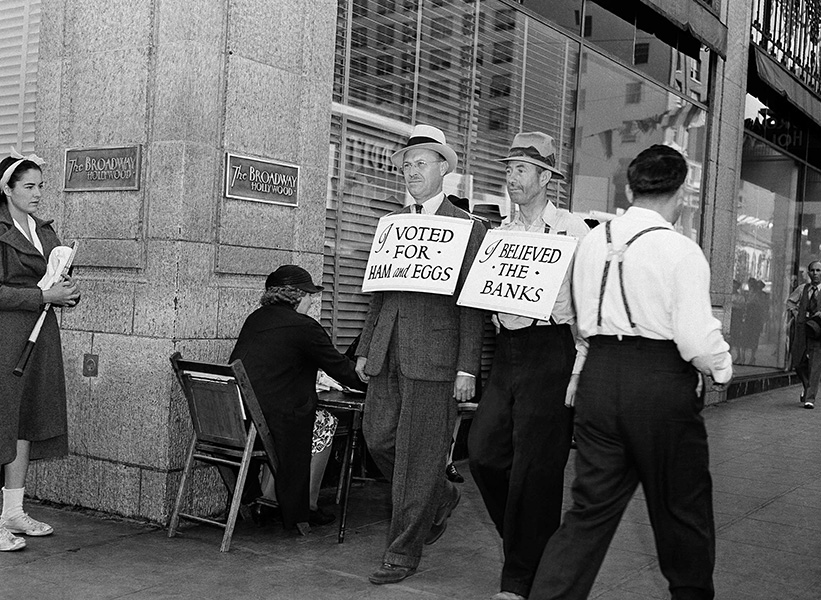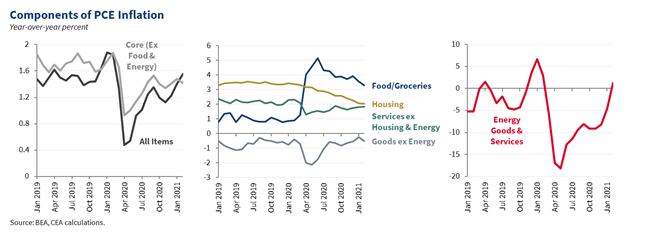Washington’s Inflation Hysteria Is Fueled by Corporate Greed
With the help of Larry Summers and a battery of conservatives, the business lobby is disingenuously warning that Biden’s recovery plans will actually wreck the economy.
TNR, April 14, 2021
I first heard about the idea of a “reserve army of the unemployed” when I was in college. Advanced by Karl Marx in chapter 25 of Capital: Volume I, the theory is that it is in the interest of capitalists to maintain a relatively high rate of unemployment. This keeps workers under control and makes them fearful to ask for higher wages or unionize, lest they be replaced by machines, the unemployed, or under-employed eager to take their jobs. “Relative surplus population,” Marx said, is the “pivot upon which the law of demand and supply of labor works.”
I thought this idea was nonsensical at the time. I saw no way that an individual business could do anything to keep the unemployment rate above the market-clearing level. An employer is always going to hire as many workers as it needs to produce maximum profits at the wage it can afford to pay. While in theory I could see how unemployment generally might benefit businessmen by holding down wages, I could see no means by which they might engineer their preferred rate.
This was, of course, very naïve. The business community as a whole is well represented in Washington by various organizations, all of whom can be depended upon to oppose measures, such as a higher minimum wage or government jobs program, that would benefit workers too much. This influential community was successful in getting Barack Obama to scale-back his stimulus program in 2009; they are pressuring Joe Biden now to do the same with his infrastructure plan.
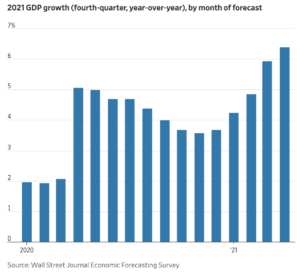 Business organizations such as the U.S. Chamber of Commerce communicate these notions to legislators and policymakers through their lobbyists and campaign contributions, while any number of pundits at The Wall Street Journal, CNBC and elsewhere echo it. They can be relied upon to convey a philosophy, now very much in evidence, that inflation is quickly becoming a more serious problem than unemployment. Over time, worries about the effects of inflation have tended to make Washington extremely skittish—this week’s news that the Consumer Price Index jumped by 2.6 percent last month already has lawmakers urging calm. Nevertheless, both The Washington Post and The New York Times are out with reports this week, stressing that the White House, amid their big plans to release another round of stimulus in the form of an infrastructure package, are ever on guard, “quietly keeping tabs” on inflation.
Business organizations such as the U.S. Chamber of Commerce communicate these notions to legislators and policymakers through their lobbyists and campaign contributions, while any number of pundits at The Wall Street Journal, CNBC and elsewhere echo it. They can be relied upon to convey a philosophy, now very much in evidence, that inflation is quickly becoming a more serious problem than unemployment. Over time, worries about the effects of inflation have tended to make Washington extremely skittish—this week’s news that the Consumer Price Index jumped by 2.6 percent last month already has lawmakers urging calm. Nevertheless, both The Washington Post and The New York Times are out with reports this week, stressing that the White House, amid their big plans to release another round of stimulus in the form of an infrastructure package, are ever on guard, “quietly keeping tabs” on inflation.
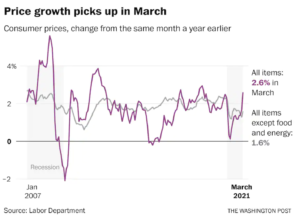 As the Post’s Hamza Shaban reports, “federal officials have stressed that the shift will probably be short-lived, as parts of the economy begin to normalize after more than a year of the pandemic.” This move, to calm the waters, is necessary. Fear of inflation is the main cudgel the business lobby uses to beat back policies that would raise wages, reduce unemployment, or promote unionization. One way they achieve these ends is by claiming that “business confidence” is extremely fragile and must be maintained at all cost if the economy is to expand. Even progressive presidents in a much stronger political position than Joe Biden currently enjoys have been seduced by this argument. In 1937, for example, Franklin Roosevelt slashed government spending while the newly-enacted payroll tax raised revenues sharply. (Social Security benefits weren’t paid out until 1940.) The result was a virtual balanced budget in fiscal year 1938—which brought on a sharp recession.
As the Post’s Hamza Shaban reports, “federal officials have stressed that the shift will probably be short-lived, as parts of the economy begin to normalize after more than a year of the pandemic.” This move, to calm the waters, is necessary. Fear of inflation is the main cudgel the business lobby uses to beat back policies that would raise wages, reduce unemployment, or promote unionization. One way they achieve these ends is by claiming that “business confidence” is extremely fragile and must be maintained at all cost if the economy is to expand. Even progressive presidents in a much stronger political position than Joe Biden currently enjoys have been seduced by this argument. In 1937, for example, Franklin Roosevelt slashed government spending while the newly-enacted payroll tax raised revenues sharply. (Social Security benefits weren’t paid out until 1940.) The result was a virtual balanced budget in fiscal year 1938—which brought on a sharp recession.
The economist Michael Kalecki has explained that the perceived importance of business confidence gives the business community a strong weapon against government programs that would create jobs and raise wages. As he explained in a 1943 essay:
Every widening of state activity is looked upon by “business” with suspicion, but the creation of employment by government spending has a special aspect which makes the opposition particularly intense…. This gives to the capitalists a powerful indirect control over government policy: everything which may shake the state of confidence must be carefully avoided because it would cause an economic crisis…. The social function of the doctrine of “sound finance” is to make the level of employment dependent on the “state of confidence.”
The notion that there is an inherent trade-off between inflation and unemployment is codified in the concept of a Non-Accelerating Inflation Rate of Unemployment, or NAIRU, that underlies all macroeconomic analysis. Every time you hear a prominent economist such as Larry Summers warn that the economy is in danger of “overheating,” he is saying that inflation will result if unemployment falls too low or wages rise too much. The fact that Summers served as Treasury secretary for Bill Clinton shows that the NAIRU concept is bipartisan.
In an interview with The Financial Times on April 12, Summers again articulated a common concern among those in the business community. The fiscal stimulus proposed by Joe Biden, he said, may lead to “rising inflation and a ratcheting-up of inflation expectations.” This could lead to a euphoric boom that would ultimately end in a financial crash of historic proportion, or force the Federal Reserve to hike interest rates and bring on a recession, Summers said.
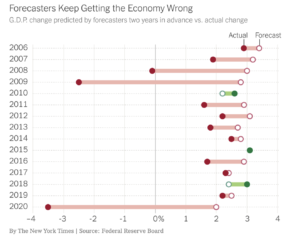 Faced with such choices, it is no wonder that the United States has never implemented a full employment policy, even though it is required to do so by law. The Employment Act of 1946 mandates that the government promote “conditions under which there will be afforded useful employment for those able, willing, and seeking work, and to promote maximum employment, production, and purchasing power.”
Faced with such choices, it is no wonder that the United States has never implemented a full employment policy, even though it is required to do so by law. The Employment Act of 1946 mandates that the government promote “conditions under which there will be afforded useful employment for those able, willing, and seeking work, and to promote maximum employment, production, and purchasing power.”
In the 1970s, Congress took note of the failure of policymakers, especially at the Federal Reserve, to follow the full employment mandate and reiterated its insistence that this mandate be implemented. In the Full Employment and Balanced Growth Act of 1978, it committed the federal government to “use all practicable programs and policies to promote full employment.”
In practice, however, the Fed has always put low inflation above maximum employment when conducting policy. Fed officials have repeatedly argued that price stability contributes meaningfully to economic growth and that sustained growth is the best means of lowering the unemployment rate. As Fed chairman Alan Greenspan put it in 2005 congressional testimony, “For our part, the Federal Reserve will pursue its statutory objectives of price stability and maximum sustainable employment—the latter of which we have learned can best be achieved in the long run by maintaining price stability.”
The Fed has also maintained that while monetary policy can control interest rates in the short-run and inflation in the long-run, it has little impact on unemployment. As the Federal Open Market Committee, the policymaking arm of the Fed, put it in a still-operational 2012 statement:
“The maximum level of employment is largely determined by nonmonetary factors that affect the structure and dynamics of the labor market. These factors may change over time and may not be directly measurable. Consequently, it would not be appropriate to specify a fixed goal for employment; rather, the Committee’s policy decisions must be informed by assessments of the maximum level of employment, recognizing that such assessments are necessarily uncertain and subject to revision.”
There is a furious debate going on right now among elite economists over the likely path of inflation in the near-term. As they always do, conservatives argue that any rise in the inflation rate risks hyperinflation—in their telling, it’s always a slippery slope. But economists at the White House, Federal Reserve, and Goldman Sachs are more sanguine. They concede that while inflation is going to rise a bit from the unusually low level it fell to during last year’s Covid-related economic slowdown, this is a temporary phenomenon, not the beginning of a trend that might lead to the sort of crisis we saw in the 1970s.
As Fed chairman Jay Powell explained in a “60 Minutes” interview on April 11:
“The economy has changed. And what we saw in the last couple of cycles is that inflation never really moved up as unemployment went down. We had 3.5 percent unemployment, which is a 50-year low for much of the last two years before the pandemic. And inflation didn’t really react much. That means that we can afford to wait to see actual inflation appear before we raise interest rates. Now, we don’t want inflation to go up materially above 2 percent and go back to, you know, the bad, old inflation days that we had when you and I were in college back a long time ago. But at the same time, we do have the ability to wait to see real inflation. And that’s what we plan on doing.”
Related to the question of whether the government should do more to achieve full employment is whether it ought to be more cognizant of the impact of monetary policy on minorities, who tend to be the first-fired and last-hired during business cycles and thus more vulnerable to the knock-on effects of moves to tighten credit and slow the economy due to inflation fears.
Last year, Federal Reserve Bank of Atlanta president Raphael Bostic, who is Black, said that the Fed “can play an important role in helping to reduce racial inequities and bring about a more inclusive economy.” He noted that economic inequality is a drag on economic growth, which is confirmed by academic research, and that community development is a core mission of the regional Federal Reserve banks.
During the 2020 campaign, Joe Biden urged the Fed to do more to fight racial economic inequality. His campaign released a statement in July which said:
The Federal Reserve (the Fed) plays a highly influential role in determining the overall unemployment rate, as well as that of Black and Brown people. Within its existing mandate of promoting maximum employment and stable prices, the Fed should aggressively enhance its surveillance and targeting of persistent racial gaps in jobs, wages, and wealth. Biden will work with Congress to amend the Federal Reserve Act to require the Fed to regularly report on current data and trends in racial economic gaps—and what actions the Fed is taking through its monetary and regulatory policies to close these gaps.
In an accompanying speech, Biden said that the Fed should aggressively target persistent racial gaps in jobs, wages, and wealth. A few days later, some congressional Democrats introduced the Federal Reserve Racial and Economic Equity Act, which would require the Fed to “exercise all duties and functions in a manner that fosters the elimination of disparities across racial and ethnic groups with respect to employment, income, wealth, and access to affordable credit.”
Needless to say, conservatives are strenuously opposed to this effort. National Review’s Ramesh Ponnuru said it’s pretty much impossible for the Fed to target racial inequality and that it should just stick to its core job of economic stability. George Will cited a study from the Federal Reserve Bank of New York to argue that the Fed can really only do one thing: lower interest rates. But low rates tend to exacerbate racial wealth inequality by channeling investment and subsequent gains into stocks and housing, thus bypassing Black households, which tend not to own stocks or houses.
However, former Federal Reserve economist Claudia Sahm argues that there is an important technical reason why Fed policy may unwittingly worsen the economic gap between the races. It has to do with the measurement of potential output—how much can the gross domestic product grow given the existing capital stock, labor force, productivity and so on. Measuring potential output is critical to determining how much monetary and fiscal policy can stimulate growth before it becomes inflationary.
Sahm argues that conventional measures of the output gap—the difference between current GDP and potential GDP—implicitly assume a continuation of widespread racial discrimination. I have previously reported estimates by Citigroup economists putting the cost of racial discrimination in the trillions of dollars. Elimination of such discrimination would therefore raise potential GDP and, in effect, raise the economy’s speed limit. As Sahm explains:
“Using the current approach to potential output to evaluate government programs implicitly accepts that discrimination is embedded in the economy. An unobservable, educated guess based on embedded racism should not be used to judge programs designed to push the economy to full employment and reduce inequality.”
Fed officials have a very large bully pulpit, with a direct pipeline into the financial media: The seven members of the Federal Reserve Board and the presidents of the 12 regional Federal Reserve Banks are very heavily covered and everything they say is newsworthy. This is one important avenue through which they could convey the idea that reducing racial inequality is an important way to raise potential growth.
The debate about inflation will be critical to Fed policy, Biden’s infrastructure plan, and other proposals in coming months. Conservatives will scream about every uptick in the consumer price index or any key component of it, such as the price of gasoline or food, to put the brakes on additional monetary or fiscal stimulus. But what they are really afraid of is that wages will start rising and cut into profits.
______
Bruce Bartlett () is a longtime observer and commenter on economic and political affairs in Washington, D.C., who has written for The New York Times, The Washington Post, The Wall Street Journal, USA Today, Politico, and many others. A bestselling author, his latest book is The Truth Matters: A Citizen’s Guide to Separating Facts From Lies and Stopping Fake News in Its Tracks

